Contemporary Business Economics Report: Clydebank Cooperative Society
VerifiedAdded on 2022/12/16
|10
|2079
|64
Report
AI Summary
This report delves into the contemporary business economics of the Clydebank Co-operative Society. Task 1 provides a detailed explanation of the Law of Demand, illustrating movements along the demand curve and shifts in the demand curve, along with a similar analysis of the Law of Supply, including movements and shifts of the supply curve. The analysis uses diagrams to visually represent these concepts. Task 2 offers a comparative analysis between 21st-century and 20th-century economic models, examining their differences and relevance in the context of the Clydebank Co-operative. The report provides a comprehensive understanding of microeconomic concepts and their application within a business context, offering insights into the dynamics of demand, supply, and the evolution of economic theories.
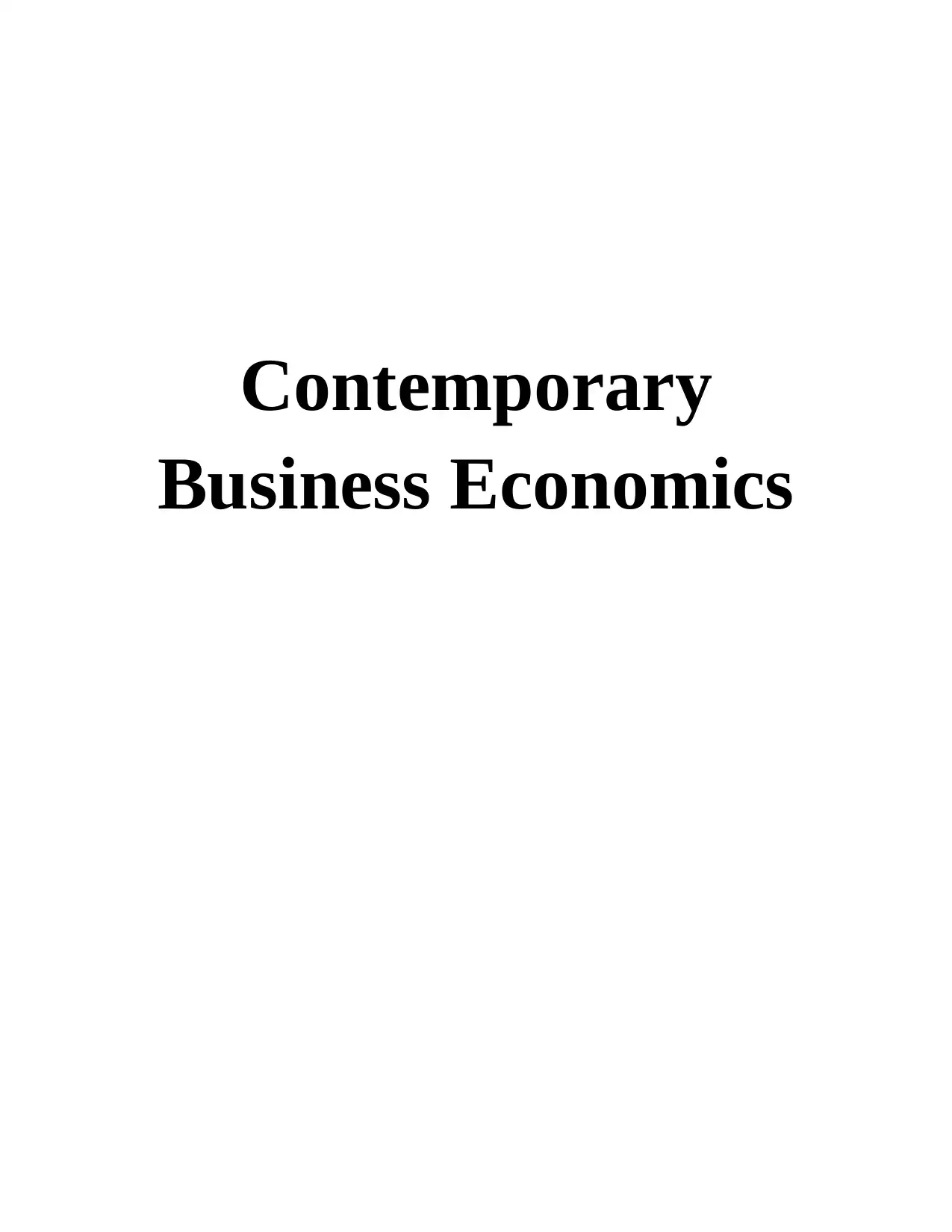
Contemporary
Business Economics
Business Economics
Paraphrase This Document
Need a fresh take? Get an instant paraphrase of this document with our AI Paraphraser
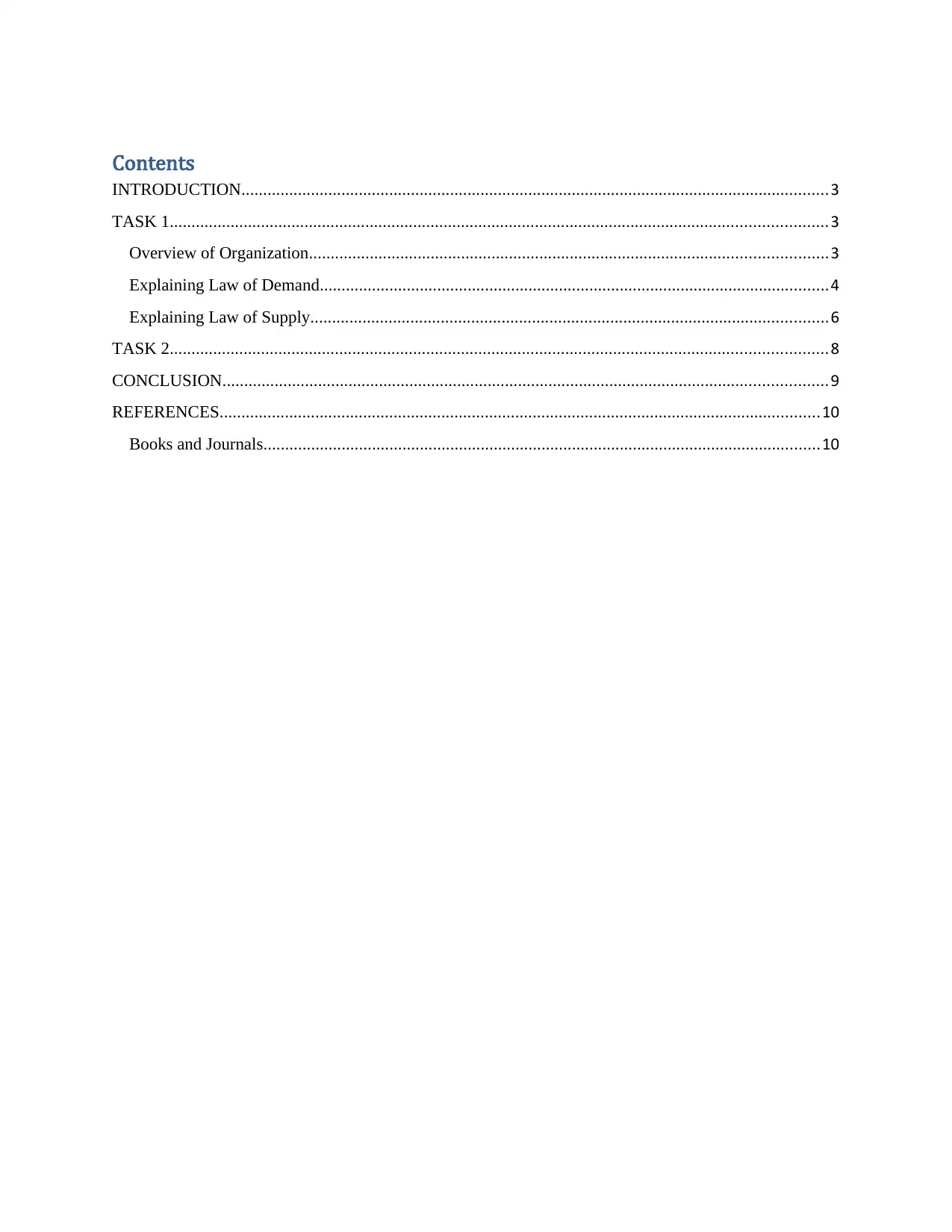
Contents
INTRODUCTION.......................................................................................................................................3
TASK 1.......................................................................................................................................................3
Overview of Organization.......................................................................................................................3
Explaining Law of Demand.....................................................................................................................4
Explaining Law of Supply.......................................................................................................................6
TASK 2.......................................................................................................................................................8
CONCLUSION...........................................................................................................................................9
REFERENCES..........................................................................................................................................10
Books and Journals................................................................................................................................10
INTRODUCTION.......................................................................................................................................3
TASK 1.......................................................................................................................................................3
Overview of Organization.......................................................................................................................3
Explaining Law of Demand.....................................................................................................................4
Explaining Law of Supply.......................................................................................................................6
TASK 2.......................................................................................................................................................8
CONCLUSION...........................................................................................................................................9
REFERENCES..........................................................................................................................................10
Books and Journals................................................................................................................................10
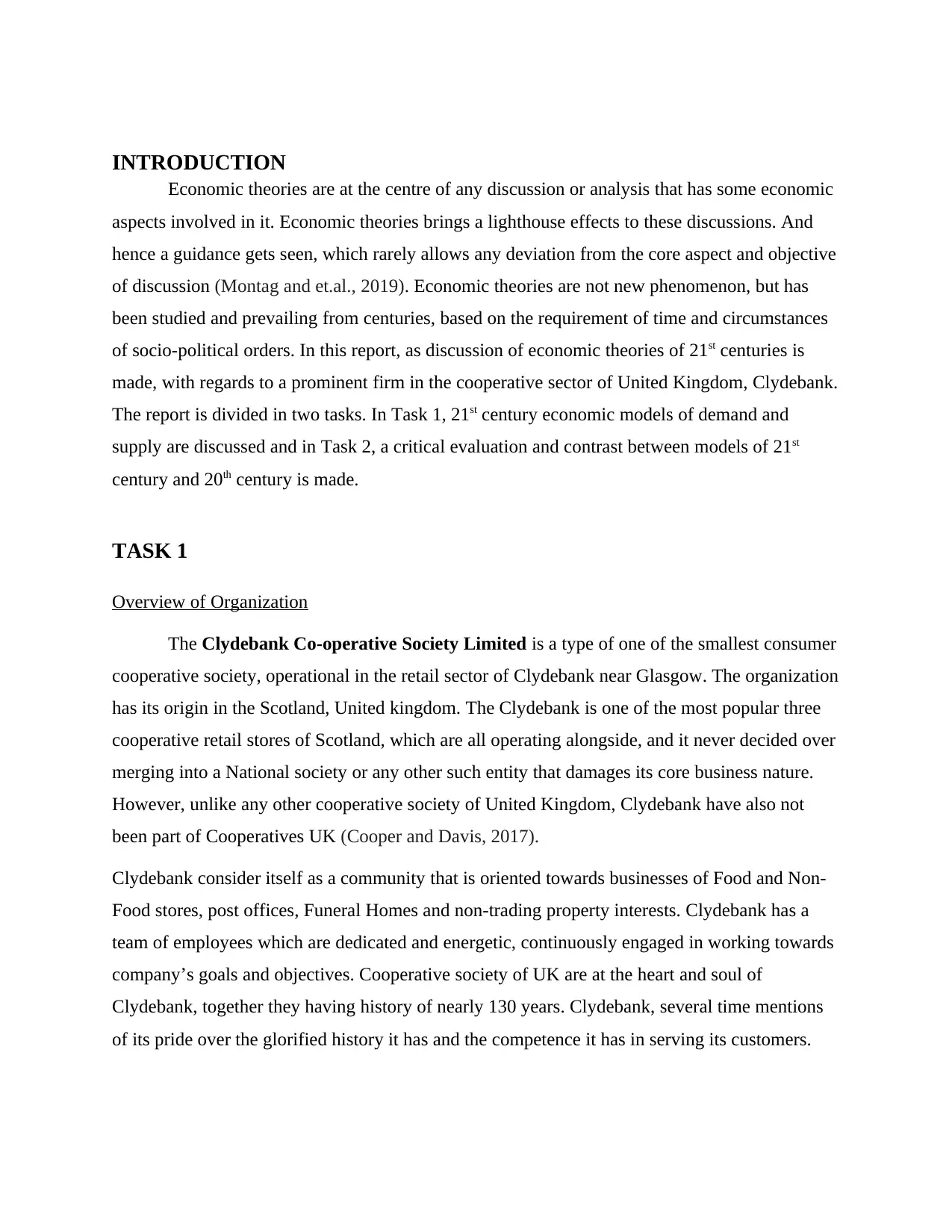
INTRODUCTION
Economic theories are at the centre of any discussion or analysis that has some economic
aspects involved in it. Economic theories brings a lighthouse effects to these discussions. And
hence a guidance gets seen, which rarely allows any deviation from the core aspect and objective
of discussion (Montag and et.al., 2019). Economic theories are not new phenomenon, but has
been studied and prevailing from centuries, based on the requirement of time and circumstances
of socio-political orders. In this report, as discussion of economic theories of 21st centuries is
made, with regards to a prominent firm in the cooperative sector of United Kingdom, Clydebank.
The report is divided in two tasks. In Task 1, 21st century economic models of demand and
supply are discussed and in Task 2, a critical evaluation and contrast between models of 21st
century and 20th century is made.
TASK 1
Overview of Organization
The Clydebank Co-operative Society Limited is a type of one of the smallest consumer
cooperative society, operational in the retail sector of Clydebank near Glasgow. The organization
has its origin in the Scotland, United kingdom. The Clydebank is one of the most popular three
cooperative retail stores of Scotland, which are all operating alongside, and it never decided over
merging into a National society or any other such entity that damages its core business nature.
However, unlike any other cooperative society of United Kingdom, Clydebank have also not
been part of Cooperatives UK (Cooper and Davis, 2017).
Clydebank consider itself as a community that is oriented towards businesses of Food and Non-
Food stores, post offices, Funeral Homes and non-trading property interests. Clydebank has a
team of employees which are dedicated and energetic, continuously engaged in working towards
company’s goals and objectives. Cooperative society of UK are at the heart and soul of
Clydebank, together they having history of nearly 130 years. Clydebank, several time mentions
of its pride over the glorified history it has and the competence it has in serving its customers.
Economic theories are at the centre of any discussion or analysis that has some economic
aspects involved in it. Economic theories brings a lighthouse effects to these discussions. And
hence a guidance gets seen, which rarely allows any deviation from the core aspect and objective
of discussion (Montag and et.al., 2019). Economic theories are not new phenomenon, but has
been studied and prevailing from centuries, based on the requirement of time and circumstances
of socio-political orders. In this report, as discussion of economic theories of 21st centuries is
made, with regards to a prominent firm in the cooperative sector of United Kingdom, Clydebank.
The report is divided in two tasks. In Task 1, 21st century economic models of demand and
supply are discussed and in Task 2, a critical evaluation and contrast between models of 21st
century and 20th century is made.
TASK 1
Overview of Organization
The Clydebank Co-operative Society Limited is a type of one of the smallest consumer
cooperative society, operational in the retail sector of Clydebank near Glasgow. The organization
has its origin in the Scotland, United kingdom. The Clydebank is one of the most popular three
cooperative retail stores of Scotland, which are all operating alongside, and it never decided over
merging into a National society or any other such entity that damages its core business nature.
However, unlike any other cooperative society of United Kingdom, Clydebank have also not
been part of Cooperatives UK (Cooper and Davis, 2017).
Clydebank consider itself as a community that is oriented towards businesses of Food and Non-
Food stores, post offices, Funeral Homes and non-trading property interests. Clydebank has a
team of employees which are dedicated and energetic, continuously engaged in working towards
company’s goals and objectives. Cooperative society of UK are at the heart and soul of
Clydebank, together they having history of nearly 130 years. Clydebank, several time mentions
of its pride over the glorified history it has and the competence it has in serving its customers.
⊘ This is a preview!⊘
Do you want full access?
Subscribe today to unlock all pages.

Trusted by 1+ million students worldwide
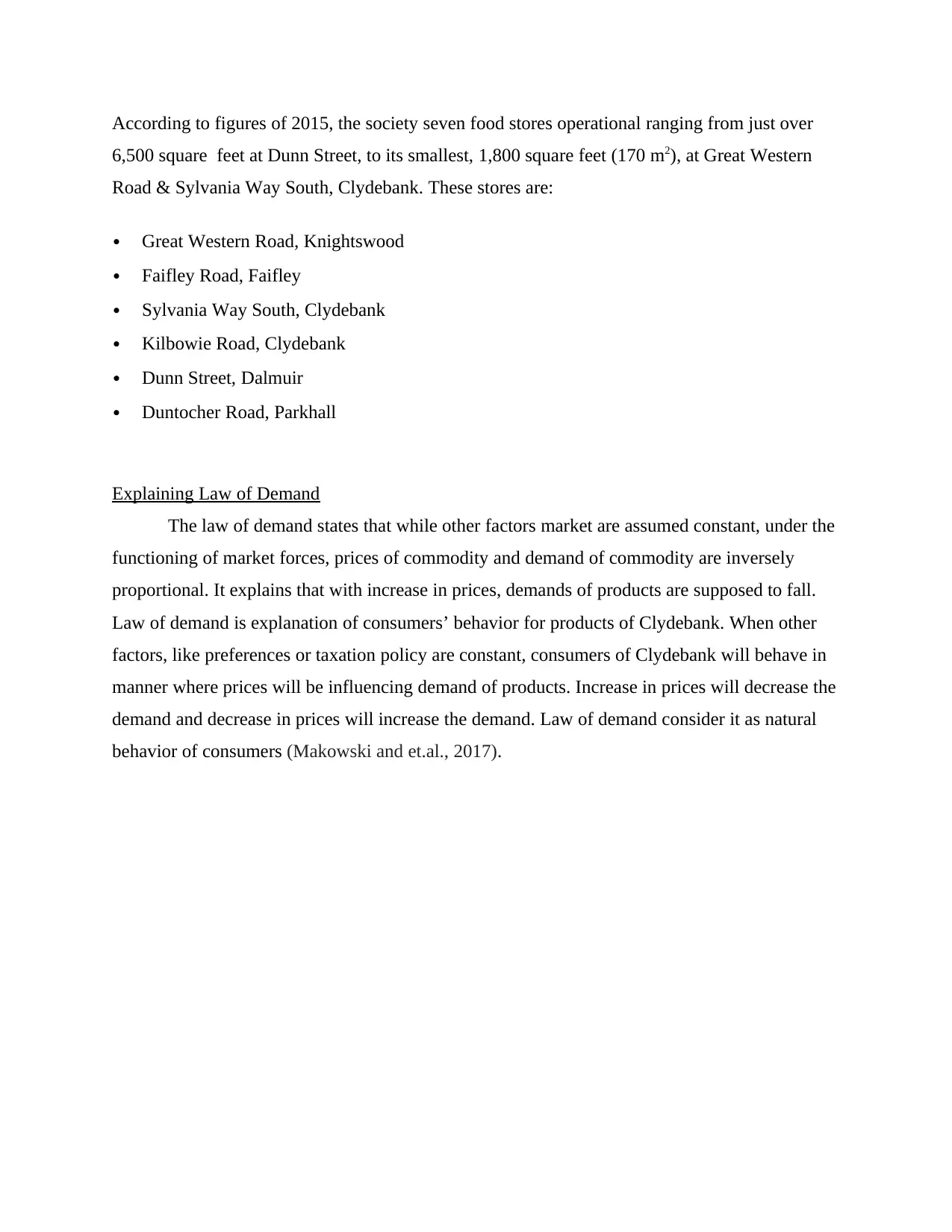
According to figures of 2015, the society seven food stores operational ranging from just over
6,500 square feet at Dunn Street, to its smallest, 1,800 square feet (170 m2), at Great Western
Road & Sylvania Way South, Clydebank. These stores are:
Great Western Road, Knightswood
Faifley Road, Faifley
Sylvania Way South, Clydebank
Kilbowie Road, Clydebank
Dunn Street, Dalmuir
Duntocher Road, Parkhall
Explaining Law of Demand
The law of demand states that while other factors market are assumed constant, under the
functioning of market forces, prices of commodity and demand of commodity are inversely
proportional. It explains that with increase in prices, demands of products are supposed to fall.
Law of demand is explanation of consumers’ behavior for products of Clydebank. When other
factors, like preferences or taxation policy are constant, consumers of Clydebank will behave in
manner where prices will be influencing demand of products. Increase in prices will decrease the
demand and decrease in prices will increase the demand. Law of demand consider it as natural
behavior of consumers (Makowski and et.al., 2017).
6,500 square feet at Dunn Street, to its smallest, 1,800 square feet (170 m2), at Great Western
Road & Sylvania Way South, Clydebank. These stores are:
Great Western Road, Knightswood
Faifley Road, Faifley
Sylvania Way South, Clydebank
Kilbowie Road, Clydebank
Dunn Street, Dalmuir
Duntocher Road, Parkhall
Explaining Law of Demand
The law of demand states that while other factors market are assumed constant, under the
functioning of market forces, prices of commodity and demand of commodity are inversely
proportional. It explains that with increase in prices, demands of products are supposed to fall.
Law of demand is explanation of consumers’ behavior for products of Clydebank. When other
factors, like preferences or taxation policy are constant, consumers of Clydebank will behave in
manner where prices will be influencing demand of products. Increase in prices will decrease the
demand and decrease in prices will increase the demand. Law of demand consider it as natural
behavior of consumers (Makowski and et.al., 2017).
Paraphrase This Document
Need a fresh take? Get an instant paraphrase of this document with our AI Paraphraser
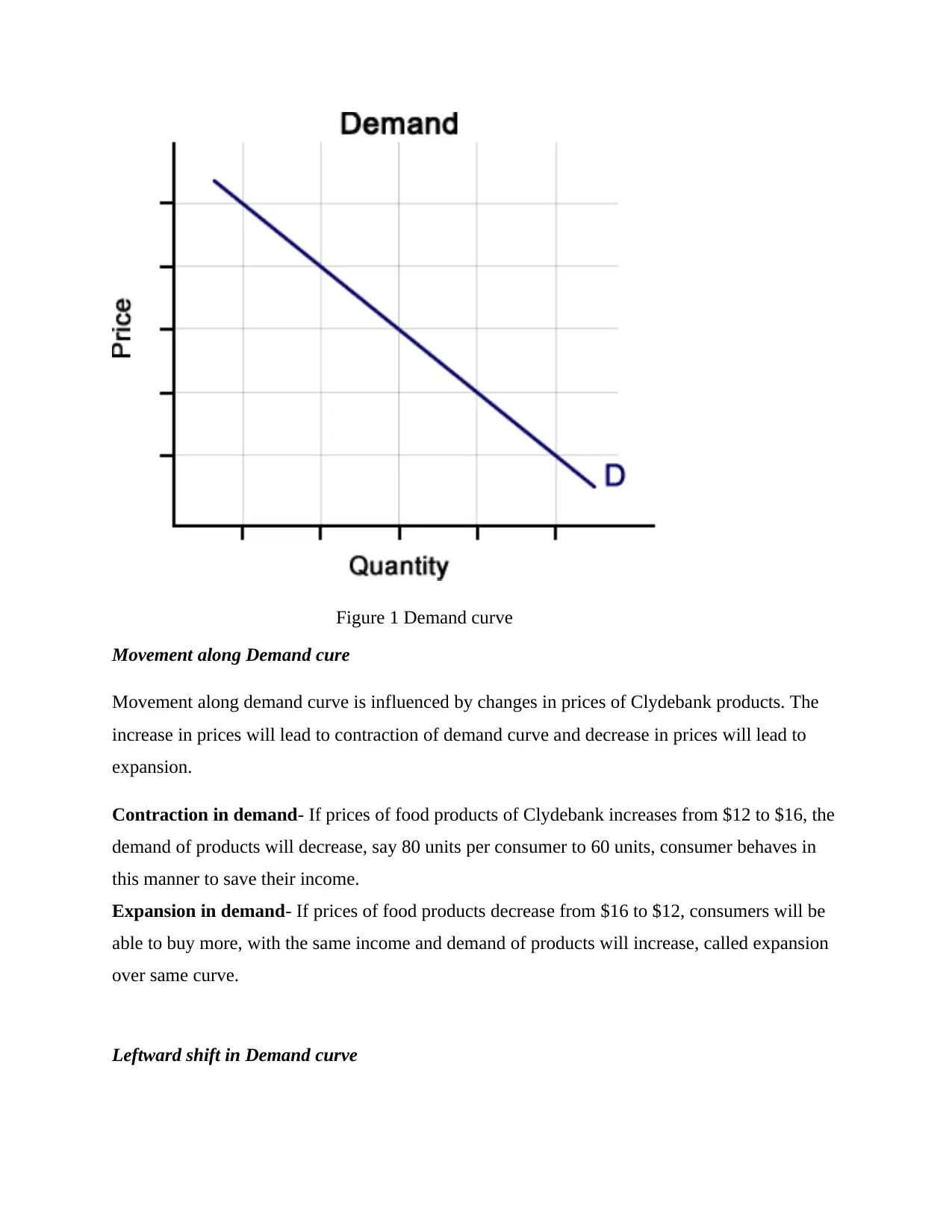
Figure 1 Demand curve
Movement along Demand cure
Movement along demand curve is influenced by changes in prices of Clydebank products. The
increase in prices will lead to contraction of demand curve and decrease in prices will lead to
expansion.
Contraction in demand- If prices of food products of Clydebank increases from $12 to $16, the
demand of products will decrease, say 80 units per consumer to 60 units, consumer behaves in
this manner to save their income.
Expansion in demand- If prices of food products decrease from $16 to $12, consumers will be
able to buy more, with the same income and demand of products will increase, called expansion
over same curve.
Leftward shift in Demand curve
Movement along Demand cure
Movement along demand curve is influenced by changes in prices of Clydebank products. The
increase in prices will lead to contraction of demand curve and decrease in prices will lead to
expansion.
Contraction in demand- If prices of food products of Clydebank increases from $12 to $16, the
demand of products will decrease, say 80 units per consumer to 60 units, consumer behaves in
this manner to save their income.
Expansion in demand- If prices of food products decrease from $16 to $12, consumers will be
able to buy more, with the same income and demand of products will increase, called expansion
over same curve.
Leftward shift in Demand curve
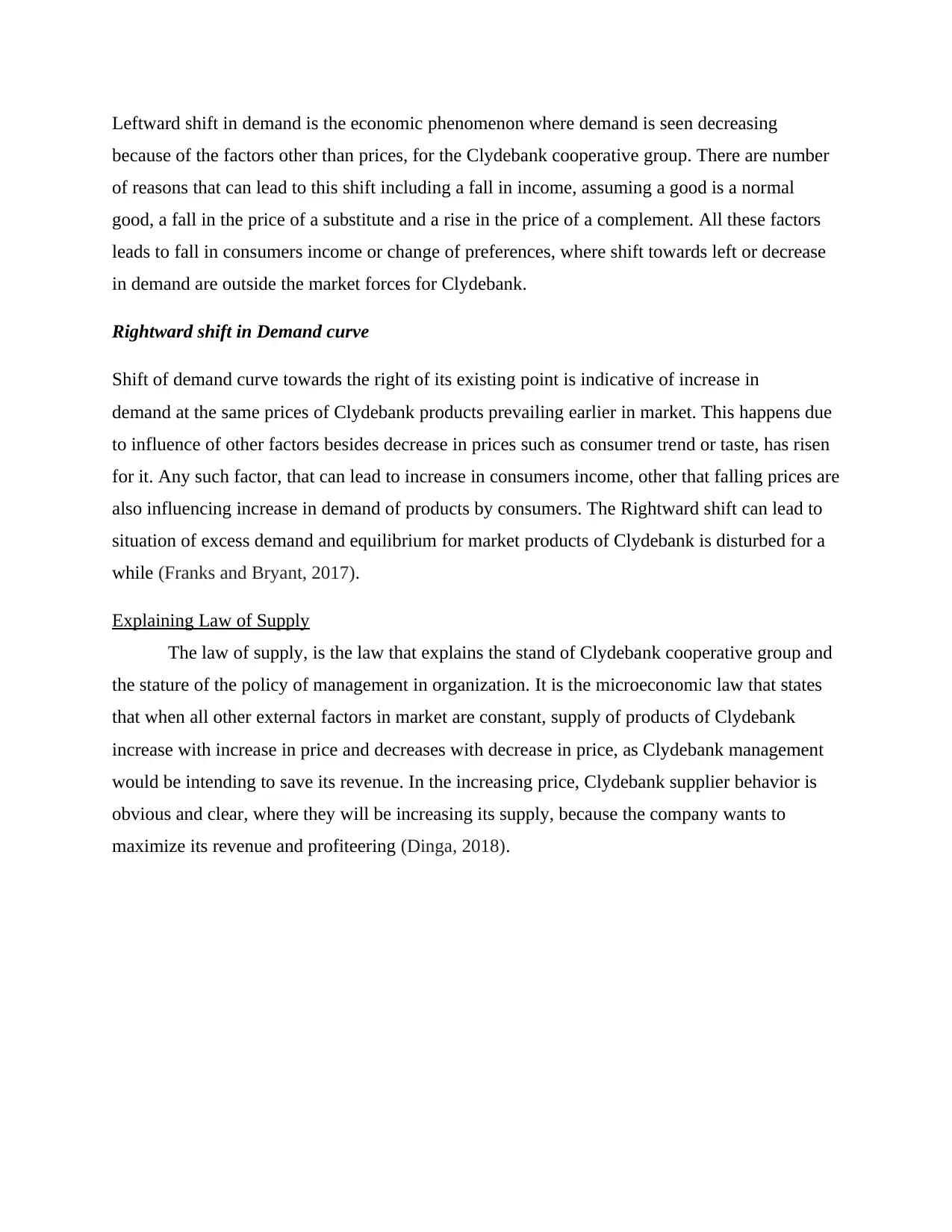
Leftward shift in demand is the economic phenomenon where demand is seen decreasing
because of the factors other than prices, for the Clydebank cooperative group. There are number
of reasons that can lead to this shift including a fall in income, assuming a good is a normal
good, a fall in the price of a substitute and a rise in the price of a complement. All these factors
leads to fall in consumers income or change of preferences, where shift towards left or decrease
in demand are outside the market forces for Clydebank.
Rightward shift in Demand curve
Shift of demand curve towards the right of its existing point is indicative of increase in
demand at the same prices of Clydebank products prevailing earlier in market. This happens due
to influence of other factors besides decrease in prices such as consumer trend or taste, has risen
for it. Any such factor, that can lead to increase in consumers income, other that falling prices are
also influencing increase in demand of products by consumers. The Rightward shift can lead to
situation of excess demand and equilibrium for market products of Clydebank is disturbed for a
while (Franks and Bryant, 2017).
Explaining Law of Supply
The law of supply, is the law that explains the stand of Clydebank cooperative group and
the stature of the policy of management in organization. It is the microeconomic law that states
that when all other external factors in market are constant, supply of products of Clydebank
increase with increase in price and decreases with decrease in price, as Clydebank management
would be intending to save its revenue. In the increasing price, Clydebank supplier behavior is
obvious and clear, where they will be increasing its supply, because the company wants to
maximize its revenue and profiteering (Dinga, 2018).
because of the factors other than prices, for the Clydebank cooperative group. There are number
of reasons that can lead to this shift including a fall in income, assuming a good is a normal
good, a fall in the price of a substitute and a rise in the price of a complement. All these factors
leads to fall in consumers income or change of preferences, where shift towards left or decrease
in demand are outside the market forces for Clydebank.
Rightward shift in Demand curve
Shift of demand curve towards the right of its existing point is indicative of increase in
demand at the same prices of Clydebank products prevailing earlier in market. This happens due
to influence of other factors besides decrease in prices such as consumer trend or taste, has risen
for it. Any such factor, that can lead to increase in consumers income, other that falling prices are
also influencing increase in demand of products by consumers. The Rightward shift can lead to
situation of excess demand and equilibrium for market products of Clydebank is disturbed for a
while (Franks and Bryant, 2017).
Explaining Law of Supply
The law of supply, is the law that explains the stand of Clydebank cooperative group and
the stature of the policy of management in organization. It is the microeconomic law that states
that when all other external factors in market are constant, supply of products of Clydebank
increase with increase in price and decreases with decrease in price, as Clydebank management
would be intending to save its revenue. In the increasing price, Clydebank supplier behavior is
obvious and clear, where they will be increasing its supply, because the company wants to
maximize its revenue and profiteering (Dinga, 2018).
⊘ This is a preview!⊘
Do you want full access?
Subscribe today to unlock all pages.

Trusted by 1+ million students worldwide
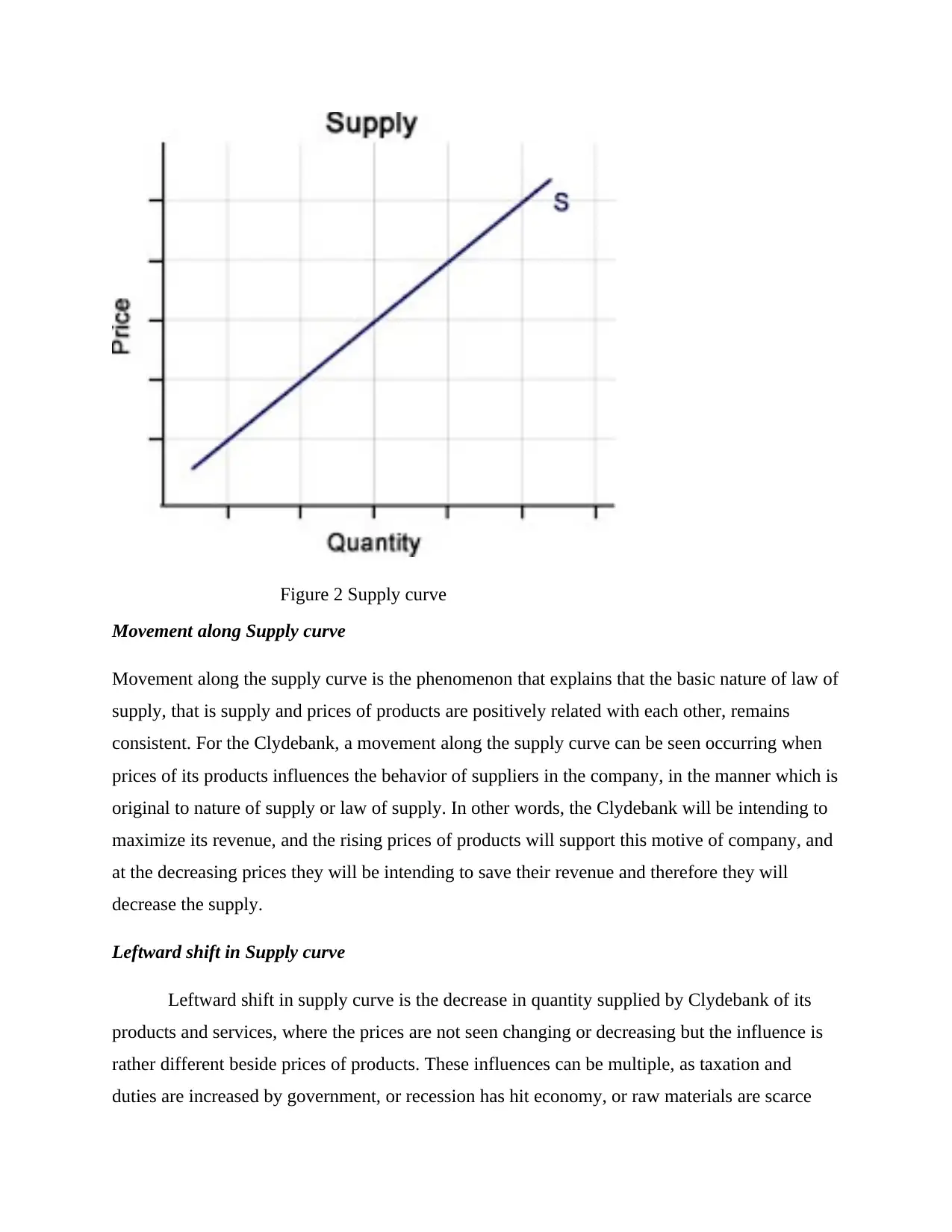
Figure 2 Supply curve
Movement along Supply curve
Movement along the supply curve is the phenomenon that explains that the basic nature of law of
supply, that is supply and prices of products are positively related with each other, remains
consistent. For the Clydebank, a movement along the supply curve can be seen occurring when
prices of its products influences the behavior of suppliers in the company, in the manner which is
original to nature of supply or law of supply. In other words, the Clydebank will be intending to
maximize its revenue, and the rising prices of products will support this motive of company, and
at the decreasing prices they will be intending to save their revenue and therefore they will
decrease the supply.
Leftward shift in Supply curve
Leftward shift in supply curve is the decrease in quantity supplied by Clydebank of its
products and services, where the prices are not seen changing or decreasing but the influence is
rather different beside prices of products. These influences can be multiple, as taxation and
duties are increased by government, or recession has hit economy, or raw materials are scarce
Movement along Supply curve
Movement along the supply curve is the phenomenon that explains that the basic nature of law of
supply, that is supply and prices of products are positively related with each other, remains
consistent. For the Clydebank, a movement along the supply curve can be seen occurring when
prices of its products influences the behavior of suppliers in the company, in the manner which is
original to nature of supply or law of supply. In other words, the Clydebank will be intending to
maximize its revenue, and the rising prices of products will support this motive of company, and
at the decreasing prices they will be intending to save their revenue and therefore they will
decrease the supply.
Leftward shift in Supply curve
Leftward shift in supply curve is the decrease in quantity supplied by Clydebank of its
products and services, where the prices are not seen changing or decreasing but the influence is
rather different beside prices of products. These influences can be multiple, as taxation and
duties are increased by government, or recession has hit economy, or raw materials are scarce
Paraphrase This Document
Need a fresh take? Get an instant paraphrase of this document with our AI Paraphraser
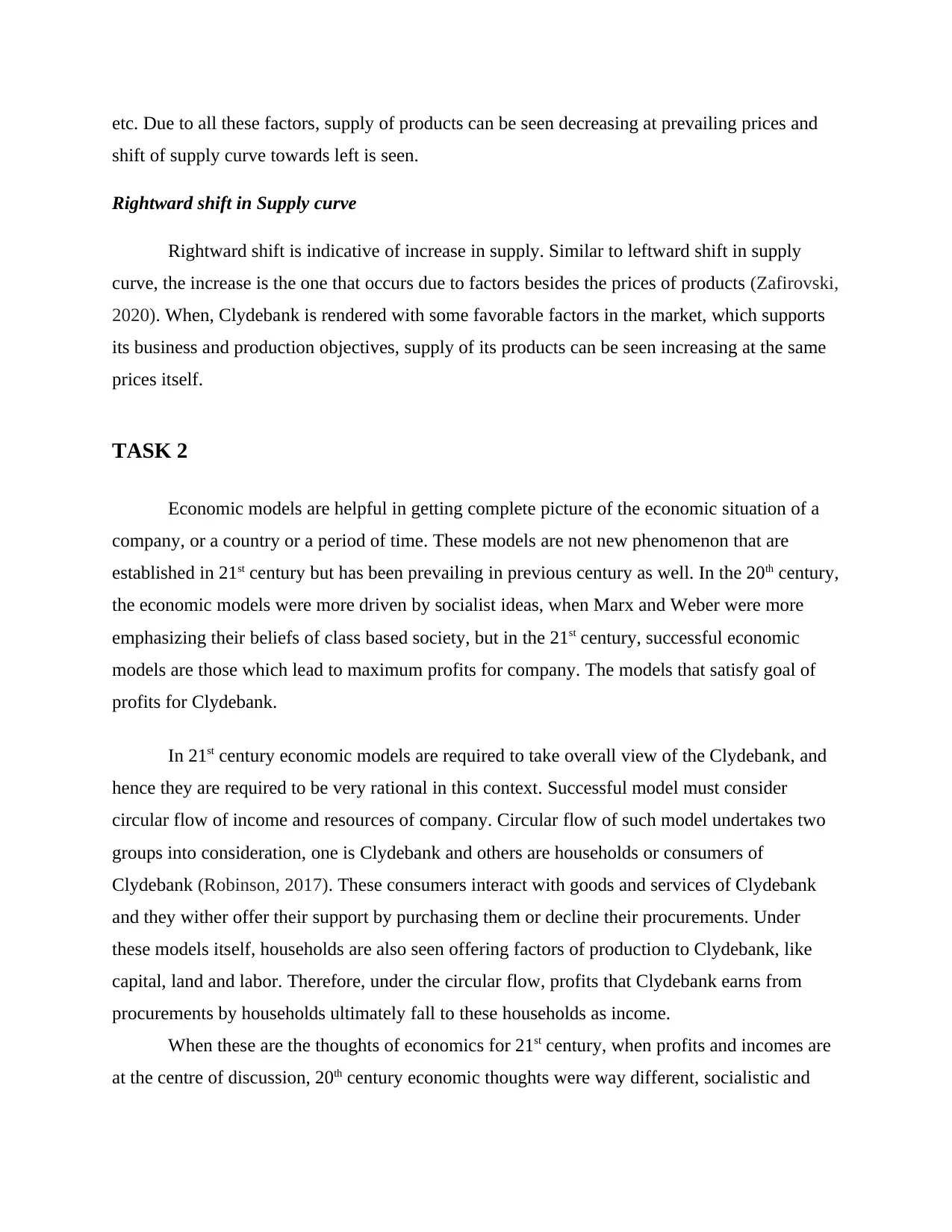
etc. Due to all these factors, supply of products can be seen decreasing at prevailing prices and
shift of supply curve towards left is seen.
Rightward shift in Supply curve
Rightward shift is indicative of increase in supply. Similar to leftward shift in supply
curve, the increase is the one that occurs due to factors besides the prices of products (Zafirovski,
2020). When, Clydebank is rendered with some favorable factors in the market, which supports
its business and production objectives, supply of its products can be seen increasing at the same
prices itself.
TASK 2
Economic models are helpful in getting complete picture of the economic situation of a
company, or a country or a period of time. These models are not new phenomenon that are
established in 21st century but has been prevailing in previous century as well. In the 20th century,
the economic models were more driven by socialist ideas, when Marx and Weber were more
emphasizing their beliefs of class based society, but in the 21st century, successful economic
models are those which lead to maximum profits for company. The models that satisfy goal of
profits for Clydebank.
In 21st century economic models are required to take overall view of the Clydebank, and
hence they are required to be very rational in this context. Successful model must consider
circular flow of income and resources of company. Circular flow of such model undertakes two
groups into consideration, one is Clydebank and others are households or consumers of
Clydebank (Robinson, 2017). These consumers interact with goods and services of Clydebank
and they wither offer their support by purchasing them or decline their procurements. Under
these models itself, households are also seen offering factors of production to Clydebank, like
capital, land and labor. Therefore, under the circular flow, profits that Clydebank earns from
procurements by households ultimately fall to these households as income.
When these are the thoughts of economics for 21st century, when profits and incomes are
at the centre of discussion, 20th century economic thoughts were way different, socialistic and
shift of supply curve towards left is seen.
Rightward shift in Supply curve
Rightward shift is indicative of increase in supply. Similar to leftward shift in supply
curve, the increase is the one that occurs due to factors besides the prices of products (Zafirovski,
2020). When, Clydebank is rendered with some favorable factors in the market, which supports
its business and production objectives, supply of its products can be seen increasing at the same
prices itself.
TASK 2
Economic models are helpful in getting complete picture of the economic situation of a
company, or a country or a period of time. These models are not new phenomenon that are
established in 21st century but has been prevailing in previous century as well. In the 20th century,
the economic models were more driven by socialist ideas, when Marx and Weber were more
emphasizing their beliefs of class based society, but in the 21st century, successful economic
models are those which lead to maximum profits for company. The models that satisfy goal of
profits for Clydebank.
In 21st century economic models are required to take overall view of the Clydebank, and
hence they are required to be very rational in this context. Successful model must consider
circular flow of income and resources of company. Circular flow of such model undertakes two
groups into consideration, one is Clydebank and others are households or consumers of
Clydebank (Robinson, 2017). These consumers interact with goods and services of Clydebank
and they wither offer their support by purchasing them or decline their procurements. Under
these models itself, households are also seen offering factors of production to Clydebank, like
capital, land and labor. Therefore, under the circular flow, profits that Clydebank earns from
procurements by households ultimately fall to these households as income.
When these are the thoughts of economics for 21st century, when profits and incomes are
at the centre of discussion, 20th century economic thoughts were way different, socialistic and
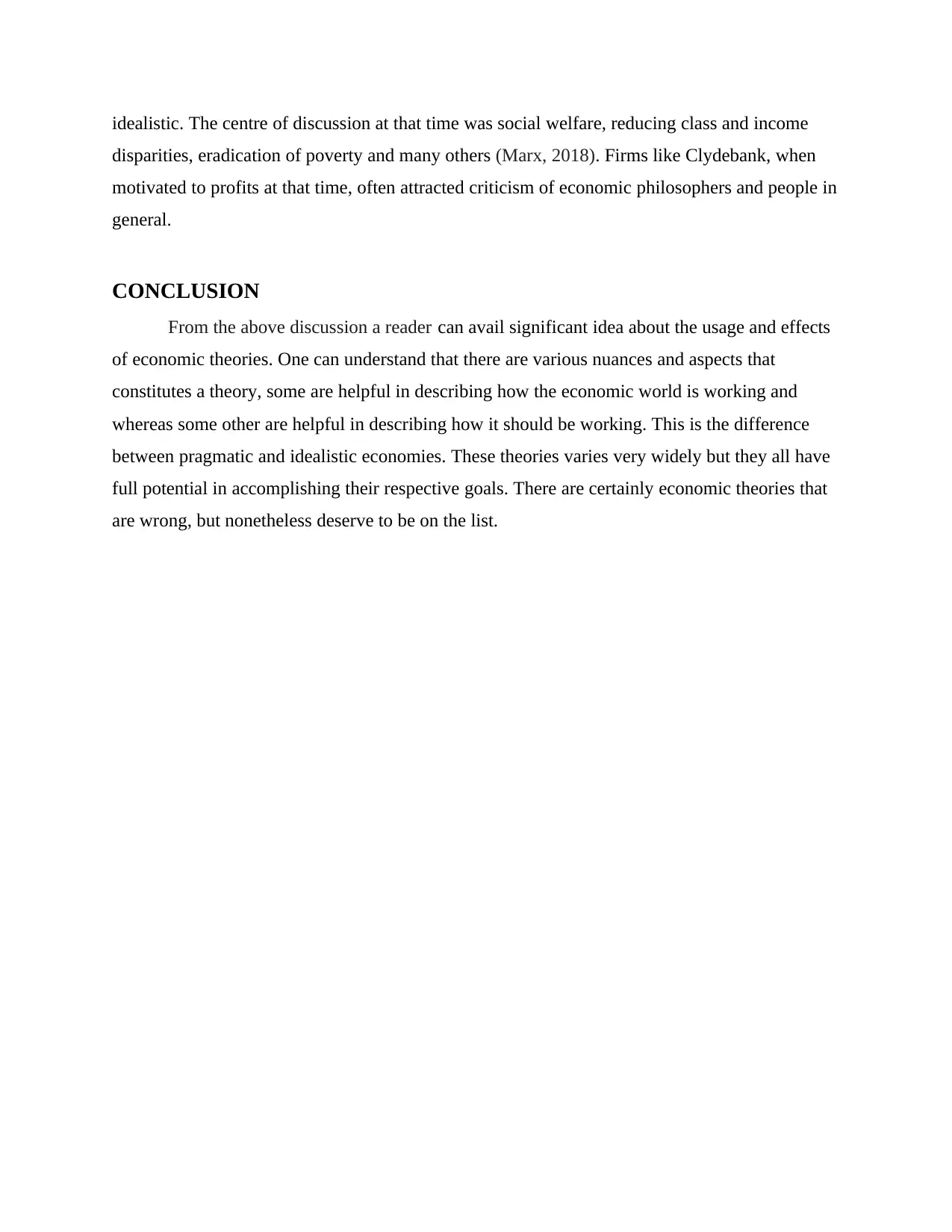
idealistic. The centre of discussion at that time was social welfare, reducing class and income
disparities, eradication of poverty and many others (Marx, 2018). Firms like Clydebank, when
motivated to profits at that time, often attracted criticism of economic philosophers and people in
general.
CONCLUSION
From the above discussion a reader can avail significant idea about the usage and effects
of economic theories. One can understand that there are various nuances and aspects that
constitutes a theory, some are helpful in describing how the economic world is working and
whereas some other are helpful in describing how it should be working. This is the difference
between pragmatic and idealistic economies. These theories varies very widely but they all have
full potential in accomplishing their respective goals. There are certainly economic theories that
are wrong, but nonetheless deserve to be on the list.
disparities, eradication of poverty and many others (Marx, 2018). Firms like Clydebank, when
motivated to profits at that time, often attracted criticism of economic philosophers and people in
general.
CONCLUSION
From the above discussion a reader can avail significant idea about the usage and effects
of economic theories. One can understand that there are various nuances and aspects that
constitutes a theory, some are helpful in describing how the economic world is working and
whereas some other are helpful in describing how it should be working. This is the difference
between pragmatic and idealistic economies. These theories varies very widely but they all have
full potential in accomplishing their respective goals. There are certainly economic theories that
are wrong, but nonetheless deserve to be on the list.
⊘ This is a preview!⊘
Do you want full access?
Subscribe today to unlock all pages.

Trusted by 1+ million students worldwide
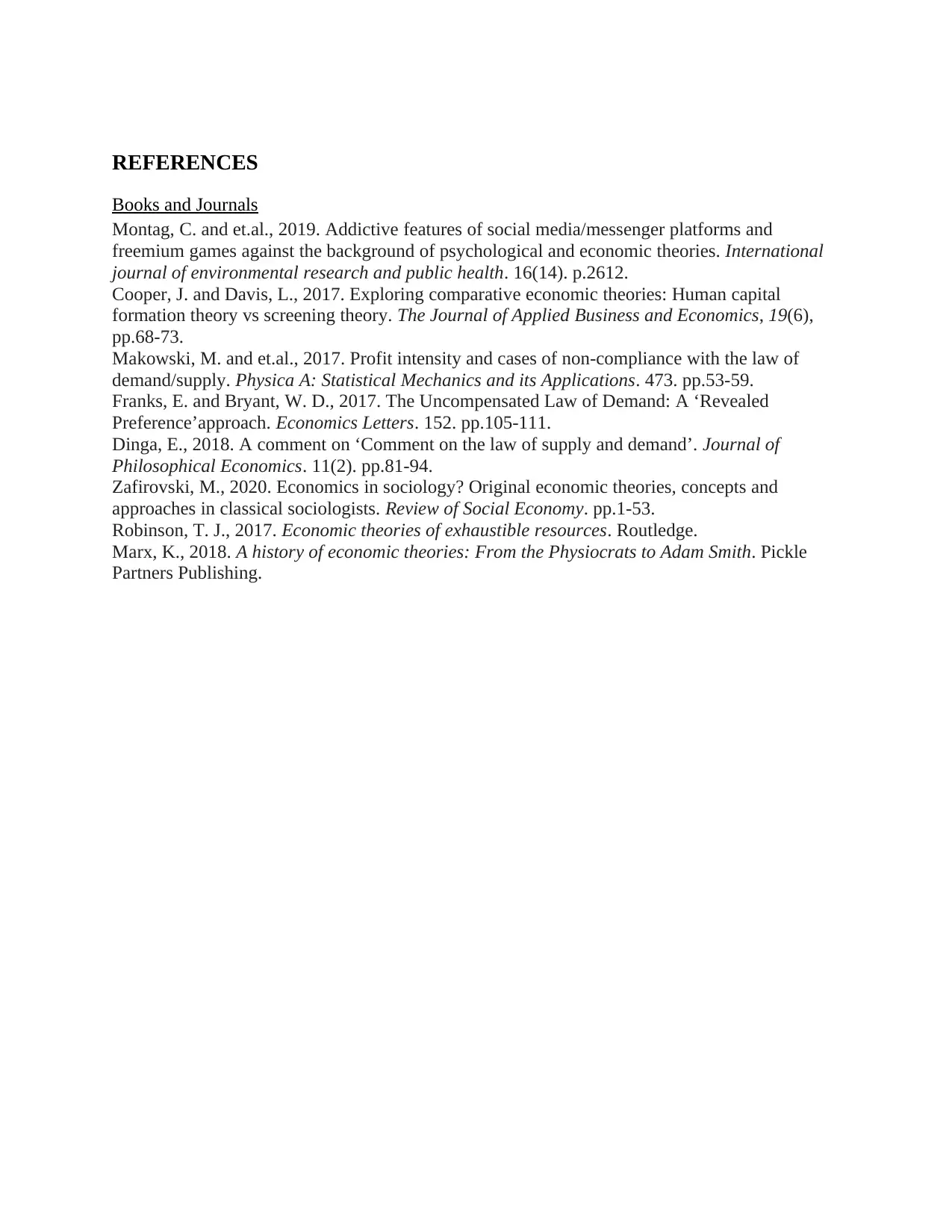
REFERENCES
Books and Journals
Montag, C. and et.al., 2019. Addictive features of social media/messenger platforms and
freemium games against the background of psychological and economic theories. International
journal of environmental research and public health. 16(14). p.2612.
Cooper, J. and Davis, L., 2017. Exploring comparative economic theories: Human capital
formation theory vs screening theory. The Journal of Applied Business and Economics, 19(6),
pp.68-73.
Makowski, M. and et.al., 2017. Profit intensity and cases of non-compliance with the law of
demand/supply. Physica A: Statistical Mechanics and its Applications. 473. pp.53-59.
Franks, E. and Bryant, W. D., 2017. The Uncompensated Law of Demand: A ‘Revealed
Preference’approach. Economics Letters. 152. pp.105-111.
Dinga, E., 2018. A comment on ‘Comment on the law of supply and demand’. Journal of
Philosophical Economics. 11(2). pp.81-94.
Zafirovski, M., 2020. Economics in sociology? Original economic theories, concepts and
approaches in classical sociologists. Review of Social Economy. pp.1-53.
Robinson, T. J., 2017. Economic theories of exhaustible resources. Routledge.
Marx, K., 2018. A history of economic theories: From the Physiocrats to Adam Smith. Pickle
Partners Publishing.
Books and Journals
Montag, C. and et.al., 2019. Addictive features of social media/messenger platforms and
freemium games against the background of psychological and economic theories. International
journal of environmental research and public health. 16(14). p.2612.
Cooper, J. and Davis, L., 2017. Exploring comparative economic theories: Human capital
formation theory vs screening theory. The Journal of Applied Business and Economics, 19(6),
pp.68-73.
Makowski, M. and et.al., 2017. Profit intensity and cases of non-compliance with the law of
demand/supply. Physica A: Statistical Mechanics and its Applications. 473. pp.53-59.
Franks, E. and Bryant, W. D., 2017. The Uncompensated Law of Demand: A ‘Revealed
Preference’approach. Economics Letters. 152. pp.105-111.
Dinga, E., 2018. A comment on ‘Comment on the law of supply and demand’. Journal of
Philosophical Economics. 11(2). pp.81-94.
Zafirovski, M., 2020. Economics in sociology? Original economic theories, concepts and
approaches in classical sociologists. Review of Social Economy. pp.1-53.
Robinson, T. J., 2017. Economic theories of exhaustible resources. Routledge.
Marx, K., 2018. A history of economic theories: From the Physiocrats to Adam Smith. Pickle
Partners Publishing.
1 out of 10
Your All-in-One AI-Powered Toolkit for Academic Success.
+13062052269
info@desklib.com
Available 24*7 on WhatsApp / Email
![[object Object]](/_next/static/media/star-bottom.7253800d.svg)
Unlock your academic potential
Copyright © 2020–2025 A2Z Services. All Rights Reserved. Developed and managed by ZUCOL.


